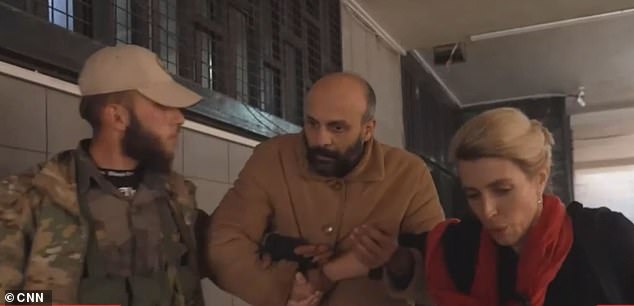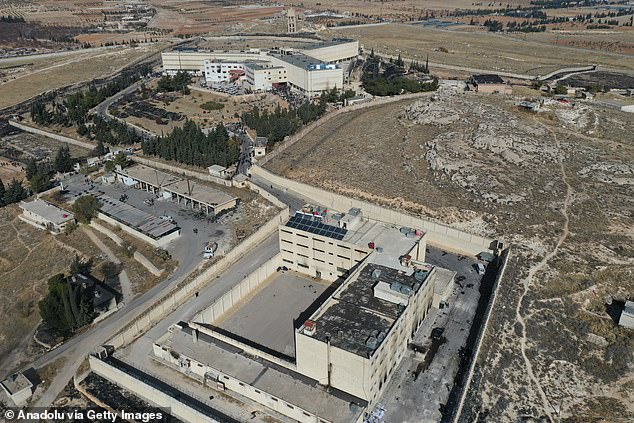The ‘hidden prisoner’ rescued from a Syrian prison by CNN was a member of Bashar al-Assad’s forces and allegedly killed and tortured civilians, a new report claims.
The prisoner was found under a blanket in a Damascus prison by the network’s chief international correspondent, Clarissa Ward, and identified herself as a “citizen” named Adel Gharbal.
The man claimed he was taken from his home in the city of Homs, arrested and interrogated through his phone contacts. He claimed that he was left without any means of sustenance for four days when his captors fled while on the run the fall of Damascus to rebel forces.
But Syrian fact-checking organization Verify-Sy has now claimed that the prisoner’s real name is Salama Mohammad Salama and that he was a first lieutenant in the Syrian Air Force intelligence service who served under former President Assad.
Salama is alleged to have killed civilians and was responsible for detaining and torturing young men in Homs on trumped-up charges, Verify-Sy reported, citing residents.
They then accused Salama of involvement in “theft, extortion and forcing residents to become informants,” and said he had taken part in military operations on several fronts in Homs in 2014.
Residents further alleged that Salama was thrown into Damascus prison less than a month ago over a dispute with a senior officer over money he had allegedly extorted.
He has since tried to gain sympathy after the fall of the regime, claiming he was “forced” to commit his crimes, according to locals.
Salama is also said to have deactivated his social media accounts and changed his phone number in an attempt to erase any evidence of his involvement in armed activities and war crimes.
CNN has launched an investigation into the viral moment when reporter Clarissa Ward and her team encountered a man locked in a cell in one of former Syrian President Bashar al-Assad’s infamous prisons.

Verify-Sy, a Syrian fact-checking site, had questions about the report
Ward was touring the detention center where countless civilians were tortured and beaten to death when her team apparently came across a cell that was still locked.
A Syrian rebel guard reportedly shot open the prison cell door and found the prisoner shaking under the blanket.
Ward provided the man – who identified himself as Gharbal, a father from Homs – with food and water. He was then led outside.
But Verify-Sy questioned the report, noting that the alleged prisoner did not flinch or blink as he looked skyward for what was believed to be the first time in months.
‘Despite the alleged harsh treatment of prisoners in secret prisons, Gharbal appeared clean, well-groomed and physically healthy, with no visible injuries or signs of torture – an incongruous image for someone reportedly held in solitary confinement in the dark for 90 days ‘ reported Verify-Sy, part of Poynter’s International Fact-Checking Network.
After further investigation, Verify-Sy said it could not confirm Gharbal’s identity, but after speaking to locals in Homs, it was able to identify him as Salama Mohammad Salama or Abu Hamza.
“Residents of Al-Bayyada neighborhood said he was regularly stationed at a checkpoint at the western entrance to the area, notorious for abuses,” Verify-Sy reported.
“Many were targeted simply because they refused to pay bribes, rejected cooperation or even for arbitrary reasons such as their appearance,” the organization claimed.

The man, identified by Verify-Sy as Salama Mohammad Salama, is pictured with Ward after the rescue

Assad’s prisons were known for their brutality, with Sednaya prison (pictured) being called a ‘human slaughterhouse’
It is unclear what happened to the man after the CNN video, when he got into a Red Crescent vehicle and drove away.
But a spokesperson for CNN told the Daily Beast the portrayal of the apparent rescued man played out exactly as they reported.
“No one other than the CNN team was aware of our plans to visit the prison building featured in our report that day,” the spokesperson said.
“The events took place as they appear in our film,” he added.
‘The decision to release the prisoner from our report was made by the guard, a Syrian rebel. We have reported the scene as it happened, including what the prisoner told us, with clear attribution.”
However, the spokesperson acknowledged that the inmate may have given Ward a false name.
“We have subsequently investigated his background and are aware that he may have provided a false identity,” the spokesperson said.
“We are continuing our reporting on this and the broader story.”
CNN’s team visited the prison during the search for missing American journalist Austin Tice, The Telegraph reported. It is understood the prison was aware of the reporting team’s visit.

A spokesperson for the network acknowledged that the inmate may have given Ward a false name and said it is investigating claims that he is not who he said he was. CNN Worldwide CEO Mark Thompson is pictured
Since the start of the Syrian revolution in March 2011, more than 157,000 people have been arrested or forcibly disappeared, including 5,274 children and 10,221 women, according to the Syrian Network for Human Rights.
The detainees included protesters, human rights defenders, political dissidents, doctors treating demonstrators or opposition members, as well as their relatives.
More than 1,500 people died under torture, which included electrocuting genitals or hanging weights; burning them with oil, metal rods, gunpowder or flammable pesticides; crushing heads between a wall and the prison cell door; inserting needles or metal pins into bodies; and depriving prisoners of clothing, bathing and toilet facilities, the Human Rights Network said.
The worst appeared to be Sednaya prison, outside Damascus, which was the size of 184 football stadiums and surrounded by two minefields.
A 2017 Amnesty International report found that thousands of people died in mass hangings in Sednaya, which it called a “human slaughterhouse.”
Between 20 and 50 people were killed every week, usually on Monday and Wednesday evenings. Amnesty estimated that between 5,000 and 13,000 people were executed between September 2011 and December 2015.

